Growing tulips - features
In order for the cultivation and care of tulips to be joyful and productive, it is necessary to remember the rules of agricultural technology for these flowers. There are a number of things to be aware of if you decide that caring for your tulips is worth the effort:
during the growing season, tulips are fed at least three times;
the appearance of tulips indicates what kind of fertilization they need: if the leaves have become narrow and do not maintain an upright position, then they lack nitrogen, and if blue appears at the edges of the leaves, this means that tulips lack phosphorus and potassium ;
in the spring, it is necessary to remove diseased plants along with the bulb, roots and a clod of earth, and fill the hole for disinfection with a boiling solution of potassium permanganate;
cultivation of the land around the plants must be carried out very carefully so as not to damage the roots and leaves of flowers and thereby deprive the bulb of nutrition;
if you want tulips to bloom in large flowers the next year, and the bulb does not disintegrate into small bulbs, remove the wilted flower until a seed box is formed;
tulip bulbs do not tolerate direct sunlight, so they need to be dried in the shade;
do not apply fresh manure as fertilizer, this contributes to rotting of the bulbs and exposes tulips to the risk of fungal diseases;
in winters with little snow and cold, tulips need mulching with humus, peat, straw or sawdust;
when cutting tulips, leave 2-3 leaves on the plant so that the bulb can feed and develop normally;
on the site where you decided to plant tulips, they should not have grown before that for at least three years.
Correct planting of tulips in the fall in the suburbs
Professionals are planting tulips in the fall in the Urals. When exactly it is worth planting, depends only on what region you live in, as well as what climate prevails in it.
So when and how to plant tulips
- If you live in the middle lane, then planting should be done in the last days of September.
- In the event that the region is southern, then the bulbs should be planted in early October, if the temperature does not exceed 7-10 degrees.
How they bloom
Roots will form about 3-4 weeks, but the weather plays a significant role, which can speed up or slow down this process. Therefore, weather conditions affect when to plant tulip bulbs.
If the bulbs are planted ahead of time, then rooting will be more difficult or the planting material will be affected by Fusarium. Weeds that appear in warm weather can also cause a problem, because they are the ones that take away all the strength of future tulips.
When tulips have to be planted at a later time, the process may not bring the desired results. Frosts can affect the root system that has not had time to form, which will lead to rotting and death of the bulb. If the plant managed to survive, then bloom and grow, it will be much worse than those tulips that were planted in accordance with all the rules.
The bulbs planted in November should definitely be covered with spruce branches or foliage, which will provide them with a decent winter.
Is it possible to plant tulips in the spring in the garden
The correct planting of tulips in the spring in the Moscow region requires special preparation, which will help them to settle down better. And the most important problem will be how to plant tulips in the spring so that they bloom.
The first thing to do is to harden the bulbs by placing them in the refrigerator in the lower drawers, where the temperature will be about +4 degrees.In addition, the planting material must be placed in a slightly pinkish solution of potassium permanganate for 30 minutes, which will protect the bulbs from various infections and parasites.
Remember that you can only grow beautiful and strong flowers from healthy planting materials.
How to choose a place and prepare it
- Tulips feel best in areas where open sunlight falls.
- Protect them from strong gusty winds.
- The chosen place should be level and without groundwater when it comes time to plant tulips in open ground
- For tulips to grow and develop excellently, they need a good layer of fertile soil.
- Loose soil should be moderate and neutral in acidity.
Pay attention to which crops were grown in the place you selected earlier. Areas where flowers and vegetables were grown are suitable for planting tulips
Areas where flowers and vegetables were grown are suitable for planting tulips.
If nightshade and bulbous crops grew in the chosen place, then there is a risk of infection with viral diseases.
What should be the soil
From what kind of land you plant tulips in, it will come how healthy and beautiful they will grow. For planting, loose, nutrient-rich soil is suitable, which perfectly allows oxygen and air to pass through. Tulips will feel good in loamy soils and sandy loam, which are saturated with humus.
The best place where a tulip will be planted is considered to be land endowed with the following properties:
- It contains a fairly large amount of humus.
- Endowed with a neutral reaction of the environment.
- The site has been treated with the necessary preparations that increase its fertility.
If the soil contains a lot of sand, then the moisture in it will not linger for long, which means that you will have to water the flowers much more often.
Blooming terry tulips
Also, in such areas, as a rule, there are practically no nutrients, so the plant will need frequent fertilizing with mineral fertilizers.
If the soil is heavy and contains a lot of clay, then it will be much more difficult to fix it than with sandy soil. Before starting to plant tulips, it is necessary to add river sand, peat and rotted manure to such a land. Thanks to these components, the earth will conduct moisture much better, and you will avoid stagnant water.
To reduce acidity, you need chalk or lime. At a time when the plant is actively growing, the soil needs to be loosened regularly.
In those areas where tulips will soon be planted, it is necessary to apply organic fertilizers, which can be both rotted manure and compost.
Features of tulip care
The main care measures after planting are weeding and loosening the soil around the plants, pruning faded peduncles (only them, casting should remain until yellowing), watering in hot weather.
Location and lighting for the plant
For tulips, you need to choose a sunny location in the flower bed. In the neighborhood, you can plant one - or perennials that are in harmony with the color of flowers. Tulips look beautiful and bright next to evergreens. Annual plants are also good because, as they grow, they can fill the space that appears in the flowerbed in the middle of summer from the removed baskets with bulbs.
Air humidity
It does not really matter if we are not talking about greenhouse cultivation. Tulips grow and bloom successfully in any humidity. If the natural growth cycle of a plant is not disturbed, it receives enough moisture in every period of its life.
High humidity should be avoided after the bulbs have been dug. They should be dried and stored in a dry, ventilated area.
How to water properly
In the period from the beginning of sprouting in spring to flowering, it is necessary to water the tulips moderately, not leading to waterlogging.Tulips absorb available soil moisture in the immediate vicinity of the roots.
Varieties
Black tulips can be of various varieties, but none of them can be pure black. The depth of the color is also influenced by the illumination.
Black jack
Flowers have a dark purple tone, are included in a large group called "Triumph". Goblet buds that will not open. They grow up to 41-61 centimeters, have a dense stem. Tulips are suitable for cutting. Blooms in April or May.


Ronaldo
Flowers have a dark burgundy hue, are included in the "Triumph" group. These tulips are unpretentious and can grow in windy areas. They have a dense stem and bud. Flowers - medium flowering, blooming in April or May.


Queen of night
This variety is the blackest because it has a dark burgundy color. These are medium flowering plants; blooms in mid-May and blooms for 21 days. Tulips have a goblet, huge (height - 11 centimeters) flower and a dense long stem. They can grow both in a sunny place and in a partial shade. The tulip itself reaches a height of 66 centimeters.

Black and white
The variety entered the category of Rembrandt variegated tulips. The flowers are distinguished by an amazing, contrasting black and white shaded color. It is better to plant this variety away from other flowers so that the variegation virus does not occur. These flowers are of medium height (approximately 41-71 centimeters). The flowers are goblet-shaped, the petals will be able to fully open in the sunlight. Blooms in mid-May.

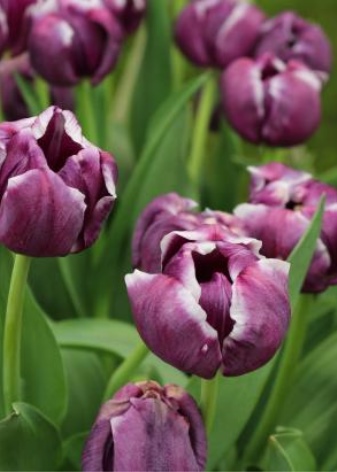
Black hero
The flowers are dark burgundy, almost black. They belong to the terry varieties, which may be called peony for their flower. The flower has 16-21 petals. The bud reaches a height of 8 centimeters, and if the plant opens completely, it can reach 12 centimeters in diameter. The black flower itself can reach a height of 51-56 centimeters. The plant blooms in late May; it can be planted in a garden with sunlight or partial shade.


Black parrot
The flowers have a dark burgundy color, wavy petals, which have green stripes. The flowers can reach a height of about 11 centimeters and a width of 21 centimeters. The stem is dense, 46 centimeters. A tulip can grow well both in the sun and in a shady place. Flowering occurs at the end of May and lasts 14-21 days. Flowers can be cut or planted in the garden.


Cuban night
The variety can be attributed to the fringed appearance, the petals at the edges have a needle-like edging. The color is black and burgundy or black and purple. The tulip blooms in May and can reach a height of 56 centimeters. The stem is dense and perfect for cutting. The tulip itself can be grown in a flower bed.
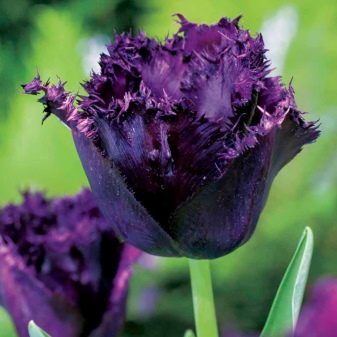

Black Beauty
The flower is black and slightly burgundy. Belongs to a simple, late type. Flowering occurs in mid-May. The stem of a tulip can grow up to 66 centimeters. The flower is dense, has a goblet shape.
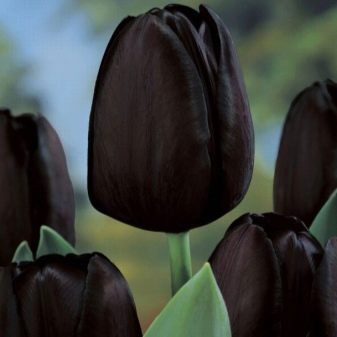

A simple portrait of a tricky tulip
Representing the Liliaceae family, tulips are, without exaggeration, the most popular and widespread bulbs. To a lesser extent, they can be called the most diverse, because the number of varieties and varieties of tulips is measured not in hundreds, but in tens of thousands, and the choice in shape, structure, and color of flowers increases from year to year. And although it is not easy to understand the classification of tulips, it is impossible to confuse tulips with other bulbs.
Representatives of the genus Tulip are bulbous perennials with a modified stem. All plant organs are laid in a pear-shaped or ovoid bulb. The generations of the bulbs change annually: during the growing season, young bulbs are laid, and the faded ones die off. The buds of peduncles and flowers develop in the bulbs during the summer dormant period. In the fall, the bulbs take root, the process of planting a peduncle is completed, and after wintering, active growth and flowering occur, and the cycle repeats again.
The development of tulips is so rapid that one cannot help but be surprised at the shortened, but amazingly active vegetation of this bulbous. Tulips quickly develop not only leaves and peduncles, but also a bulb, roots, daughter bulbs. On average, in regions with harsh winters, the entire growing season of tulips spans only 3 months from leaf formation to flowering and replacement bulbs. During a period of such active development, both conditions and care are very important for tulips, which must compensate for any vagaries of the weather.
Tulip bulbs consist of a bottom and one to six storage scales covered with protective integumentary scales. The bulbs produce underground stolons, leaves and strong, succulent flower stalks. Each bulb hides buds embedded in it, from which new bulbs are formed - the central (replacement bulb), daughter bulbs (from the buds hidden in the sinuses of storing scales) and children developing in the axils of the covering scales.
The height of tulip peduncles ranges from less than 30 cm to more than half a meter. Leaves are fleshy, grasping the stem, elongated-oval, whole-edged, rather tough, shrinking from the lower leaf to the uppermost. Up to 5 leaves sit on one stem, although tulips are often limited to only two leaves.
Tulips most often produce single flowers, in the structure of which five concentric circles can be distinguished, obeying three-ray or triangular symmetry. They are easily recognized by the six-member perianth: the flower always consists of six petals or equal to them six in number of lobes in simple tulips. Distinctive features of tulips are six, also arranged in two circles, stamens, and a three-lobed stigma of the pistil. The flowers themselves in this bulbous are strikingly diverse - from simple to double, goblet, lily-colored, cupped, oval and even star-shaped - to parrot and fantasy forms.
Colors differ by no less variety. Tulips are solid and multi-colored, pastel and bright, exotic and classic. White, pink, red, purple, yellow, orange are not the only options. The color scheme of tulips includes blue and blue, shades of green, and natural paints closest to black.
The flowering period of tulips starts with the first early varieties in April and ends only in June. Despite the extremely limited flowering period of each individual plant, the selection of tulip varieties allows you to stretch the parade of this bulbous star for almost 3 months. After flowering, dense fruit pods ripen.
The variety of tulips is simply unimaginable. More than 100 natural species, the crossing of which gave rise to more than 17 thousand registered varieties, which in turn are divided into classes, groups, subclasses, categories ... Most tulips are derived from botanical plant species from the Middle East, Central Asia and Europe. Traditionally, the market is dominated by Dutch tulips, but dozens of new varieties appear almost every year in many garden centers around the world.
The only correct criterion for choosing tulips is buying plants in accordance with your tastes and preferences, the choice is primarily based on aesthetic characteristics. After all, tulips really allow everyone to choose plants to their liking, making the collection as individual and bright as possible.
 Growing tulips. dutchgrown
Growing tulips. dutchgrown
Diseases and pests
Tulips are damaged by a huge number of pests and diseases: today there are more than 30 infections affecting tulips.
Growing tulips largely depends on the choice of planting material. Bulbs should be free from mechanical damage, ulceration, black soot spots and dry crusts.
The greatest harm to tulip plantings is caused by gray rot, fusarium, sclerocial rot. The most dangerous viral infection of a culture is variegation.
 Tulip disease - gray rot
Tulip disease - gray rot
Gray rot of tulips (Botrytis tulipae) develops on plants in cold and damp weather, especially when planted in open ground with heavy soil, which has not been loosened. The disease progresses rapidly: fungal spores spread to all parts of the plant. Growth slows down, buds become smaller, stems and leaves bend and soften. The main thing is to notice diseased plants or planting material at the time and isolate from uninfected tulips. In the spring, it is necessary to inspect seedlings to destroy diseased plants.
Preventive measures against gray rot are dusting the bulbs with sulfur, etching the bulbs with a solution of TMTD. The green mass is sprayed with Bordeaux mixture 1% or euporene 0.5-1%.
It is easy to prevent the development of the disease - a sufficient amount of potassium fertilizers should be applied to the soil, and magnesium from microelements.
 Root rot of tulips
Root rot of tulips
Root rot, causative agent - Ruthium fungi. Brown spots appear on the roots of tulips, which gradually spread to the entire root system. Properly prepared soil reduces the risk of plant diseases.
In addition, the following lesions threaten tulips: soft rot (Pythium ultimum), white rot (Scleritiniabulborum, Sclerotium tuliparium), fusarium (Fusarium oxysporum f. Sp. Tulipae), trichoderma (Trichoderma sp).
Viral diseases of tulips are represented by the most common of them - variegation. Throughout the green mass of the flower, including the petals and buds, variegated strokes appear. The virus is carried by pests with the sap of diseased plants. There is no cure. Diseased plants are destroyed.
The use of tulips in garden decoration
Tulips are spring-blooming stars that have long become indispensable for decorating any garden. They are collected, used as small seasonal accents, or turned into the main star of the spring garden. And they are grown only in groups, since it is easy for single plants to get lost.
Tulips are placed in islands, spots, "pockets" strict in shape. If the plants are planted separately, they are placed so that later it is easy to fill the area with annual stars, most often with strict contours of the tulip area. On flower beds and in complex compositions, planting in strict forms or lines is inferior in popularity to the placement of these bulbous irregular groups - from small "spots" of 5-7 bulbs to larger islets.
Tulips in the garden can be used:
- on flower beds and ceremonial flower beds;
- in discounts;
- in spring spots and islets on the lawn, under shrubs and trees;
- in borders and ribbon flower beds;
- in flower beds of annuals;
- in rock gardens and rockeries;
- in potted gardens, containers, flower girls both in the garden and on balconies, terraces, in room culture.
Tulips are a valuable cut crop. They are driven out especially for the holidays and early spring, used for complex arrangements and simple bouquets.
Late flowering tulips: peony, simple and other classes
This group is the most extensive and variegated, both in color and in the shape of the corollas, the flowers combined into it. Tulips form seven independent classes, some of which are actively developing, and some will soon become history.

White and black tulips look very impressive side by side, which in the photo are represented by the Queen of Night variety. The varieties blooming in mid-May are excellent in the flowerbed and in the cut, but they are not suitable for distillation, since they have been dormant for too long.
The extraordinarily graceful tulips Tulipa Lilyflowering form Class 6.


In Class 7 flowers of all shapes can be seen, from simple to lily or double.




If the eighth class is new, then the class 9, intended for Rembrandt variegated tulips, has no development prospects. This community of varieties, well known from the paintings of Dutch and Flemish painters of the 17th – 18th centuries, is today actually abolished, and the varieties remaining after the reorganization of the class have been transferred to other groups.







Description and names of the most popular
The black tulip group includes different varieties. Of course, none of them are completely black. In addition, lighting affects the density of the dark color.
Black jack
This variety has a dark purple color and belongs to the most numerous Triumph group. It has a classic goblet bud that never opens.
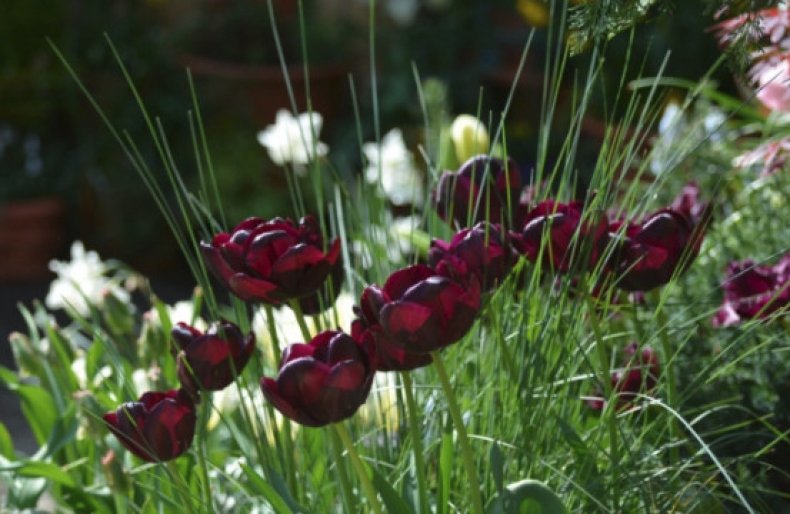
It grows up to 40-60 cm and has a strong stem, which makes it easy to cut. It blooms in April-May, suitable for forcing in a greenhouse.
Queen of night
Black and burgundy "Queen of the Night" is considered one of the blackest flowers. It belongs to the simple late-flowering varieties and blooms for about three weeks in mid-May. She has a goblet, large (about 9 cm tall) flower and a strong tall stem.
Did you know? Black tulips are not the only flowers with this color. Among the popular flowers grown by gardeners, there are almost black pansies., irises, maroon mallow, almost black mahogany-grape lily... The "Black Velvet" petunia variety has almost completely black color, and this is not the only petunia with this color, but the darkest among its kind. Among the roses, only one variety has been bred with black and burgundy petals., whose color density depends on growing conditions.
It can grow both in a sunny place and in partial shade. This tulip grows up to 65 cm. Suitable for garden decoration, forcing of medium and late periods, good for cutting for bouquets.

Black and white
Tulips of this variety belong to the variegated tulips of Rembrandt. They have a surprisingly contrasting, black and white streaky color. Initially, these flowers were affected by the variegation virus, so they should be planted in the garden separately from other varieties in order to avoid infection.
These varieties are grown with care. In the Netherlands, they even banned the cultivation of variegated species, but they made an exception for some spectacular old varieties.
This is a medium-sized tulip (40-70 cm) with a goblet flower, whose petals can fully open in the sun.
It blooms from mid-May and is suitable for cutting.
Black hero
Another tulip of maroon, almost black tones. It belongs to the late terry varieties, which are also called peony for their flower, which has 15-20 petals. The bud is usually up to 7 cm high, and in full disclosure the flower can reach 11 cm in diameter.
The tulip itself grows up to 50-55 cm and has an average growth rate. Flowering occurs at the end of May. It can be planted in the garden, both in the sun and in the shade. It is suitable for cutting and looks great in bouquets. This variety can be used for forcing in greenhouses.
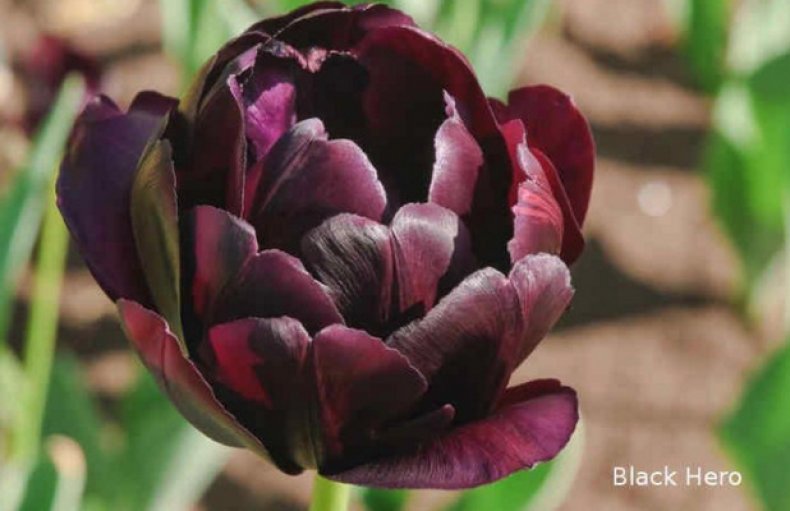
Black parrot
This maroon flower belongs to parrot tulips, characterized by wavy petals, on which green stripes are visible. The head of flowers of this variety reaches a height of 10 cm, and in width, with full disclosure of corrugated petals, sometimes up to 20 cm.
Strong stem reaches 45 cm grows well in full sun and partial shade. Blooms in late May for 2-3 weeks, the plant has an average growth rate. Good for cutting and garden decoration.

Cuban night
The black tulip of this variety belongs to the fringed species, in which the petals have an interesting needle-like edging along the edge. The color can range from black and burgundy to black and purple. It blooms in May and reaches a height of about 55 cm.
It has a strong stem and is good for cutting, looks great in bouquets. It can be grown in flower beds or used for forcing.

Black Beauty
This tulip is almost black in color with a slight burgundy tone. It belongs to the simple late species and blooms from mid-May, its stem reaches 65 cm.
It has a large goblet flower and is good for cutting, great for decorating a garden.

Correct care
After the germination of the bulbs, caring for the planting of tulips begins with a careful examination and rejection of rotten specimens.Then you need to gently loosen the bed, and the culture responds well to loosening. Caring for young plants is reduced to regular watering, but not abundant, but moderate, but the topsoil in a plant bed should never dry out.
 Tulip sprouts
Tulip sprouts
Providing regular and necessary fertilizing to growing tulips, daily careful maintenance, regular watering will help to grow healthy, vibrant flowers. And the most important thing to remember: after 4 years, tulip beds should be broken up in a different place.


